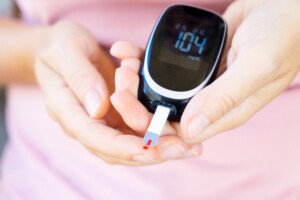
Insulin resistance or prediabetes can be successfully treated or reversed with T3, a bioidentical hormone, says Dr. Kent Holtorf, MD, thyroidologist and founder of Holtorf Medical Group in California.
Though a diagnosis of insulin resistance (prediabetes) may be issued simply because a person’s fasting glucose is between 100 and 124 mg/dL, your doctor may not officially diagnose this condition unless a few other conditions are met.
Those conditions include that of a second blood test, taken several months later, yielding a value in the prediabetes (insulin resistance) range; a body mass index of at least 25; and triglyceride levels in the “high” range.
People with insulin resistance are instructed to reverse or treat this condition by:
1) Losing weight
2) Exercising and
3) Changing their eating habits — namely, restricting high glycemic foods and increasing fiber intake.
This usually does the trick, since the common thread among people with prediabetes is lack of exercise in combination with poor eating habits and/or being overweight.
However…what if a person, upon taking the fasting glucose test that reveals prediabetes, has already been exercising, and has already been eating “healthy” for quite some time, and isn’t even overweight?
Can such a person develop prediabetes?
Dr. Holtorf says, “Genetics play a significant part, so even lean, active people can have insulin resistance.
“Interestingly, insulin resistance is associated with reduced tissue thyroid levels (not detected by standard blood tests), and treating with T3 can reverse the insulin resistance.
“We find a little thyroid optimization can dramatically reduce or reverse insulin resistance.”
If you just learned you have prediabetes (also called “impaired glucose metabolism” and “impaired glucose fasting”), and especially if you’re a lean physically fit individual who’s been restricting white sugar and high fructose corn syrup, and seemingly “doing everything right,” request from your doctor a free T3/reverse T3 ratio test.
A normal free T3/reverse T3 ratio result should be greater than 2, says Dr. Holtorf.
Treatment with T3 is that of bioidentical active thyroid, rather than a synthetic hormone. The bioidentical hormone is short-acting, and thus must be time-released.
Why isn’t T3 therapy a standard treatment for insulin resistance or prediabetes?
Dr. Holtorf explains, “Despite the large amount of literature demonstrating T3’s effectiveness and necessity for treating insulin resistance, endocrinologists and other physicians are not trained in the use of T3 in medical school and residency, so they are not comfortable using it.”
 Dr. Holtorf has published a number of endocrine reviews on complex topics in peer-reviewed journals on controversial diseases and treatments.
Dr. Holtorf has published a number of endocrine reviews on complex topics in peer-reviewed journals on controversial diseases and treatments.
 Lorra Garrick has been covering medical, fitness and cybersecurity topics for many years, having written thousands of articles for print magazines and websites, including as a ghostwriter. She’s also a former ACE-certified personal trainer.
Lorra Garrick has been covering medical, fitness and cybersecurity topics for many years, having written thousands of articles for print magazines and websites, including as a ghostwriter. She’s also a former ACE-certified personal trainer.
.









































